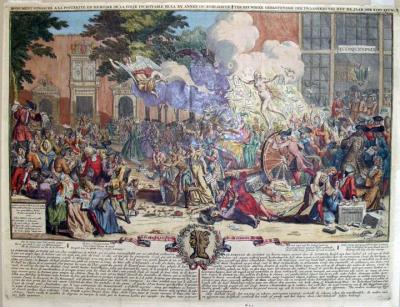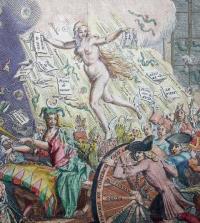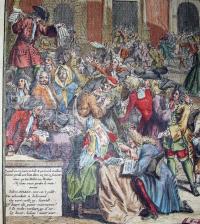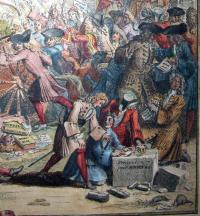The French/Dutch publisher and printmaker Bernard Picart specialized in book illustration, either for his own publications or for others. While Picart trained initially in Paris, establishing a studio on Rue St Jacques, au Buste de Monseigneur, in the late 1690s he found more work in the Netherlands. Picart turned Huguenot and settled in Amsterdam around 1711.
This print is one of several Picart published anonymously in the folio volume Het Groote Tafereel der Dwaasheid or The Great Mirror of Folly, released in Amsterdam within months of the 1720 economic crashes of the stock markets of England, France, and the Dutch Provinces. The book was published without an author or a publisher listed, although many now connect the volume largely to Picart.
The British Museum describes this print as
“satire on the financial crisis in Paris in 1720; shows a street scene in the Rue Quinquempoix, a large crowd of people are pushing a cart with Fortuna, the cart is pulled by six allegorical figures representing various investment schemes, in the sky a figure of Fame is disappearing, and a devil is blowing soap bubbles; in the right background there is an office for selling shares in the left background there are three buildings with inscriptions ‘T’Ziekenhuis’ (Hospital), ‘T’Gekkenhuis’ (Asylum) and ‘Arm-Huis’ (Poor House),with engraved French and Dutch titles, inscriptions, and French and Dutch verses two columns”.
Frans De Bruyn (Reading “Het Groote Tafereel Der Dwaasheid”, Eighteenth-Century Life, XXIV (Spring 2000), pp.1-42, nn.30, 31) points out that the scene is in Amsterdam, not Paris, where the “English” or “French” coffee-house frequented by speculators was known as the “Quinquempoix.”
While this poorly colored print was found loose in our French prints drawer, the complete volume can also be seen at Graphic Arts GAX Oversize 2006-0014F




Are you familiar with any reproductions of this engraving (Monument Consecrated to Posterity) or The Great Scene of Folly?
For more information on Picart, see Anthony Grafton's article "A Jewel of a Thousand Facets" in the NY Review of Books:
http://www.nybooks.com/articles/archives/2010/jun/24/jewel-thousand-facets/